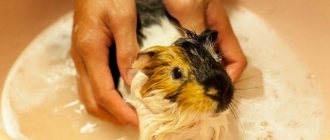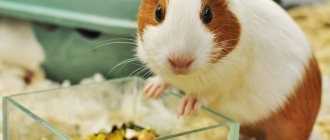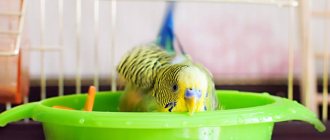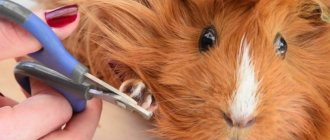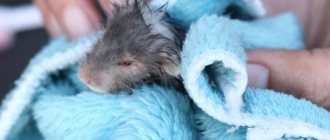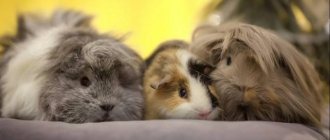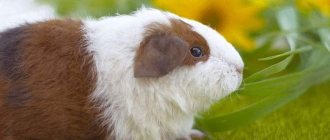Soon after purchasing a new pet, the question of how to wash a guinea pig often arises. Sometimes the animal is purchased from a pet store where the conditions were not ideal, or its fur is too long, which is difficult to clean on its own. The owner of fluffy, clean fur is much more pleasant to hold, but before arranging bath procedures for the pig, you should familiarize yourself with the features of this process.
Is it possible to bathe a guinea pig?
These decorative rodents are distinguished by cleanliness, constantly wash themselves, and carefully look after their fur. The skin fat of pigs tends to be easy to clean - owners often notice that their furry pets have almost no odor, or smell pleasantly of hay. Therefore, it is usually not necessary to bathe guinea pigs in additional water.
But there are a number of exceptions to this rule that should be taken into account:
- the thickness and length of the coat, especially in breeds bred for decorative purposes, often does not allow the animal to fully groom itself;
- the fur can get dirty in the juice of fruits and berries, and if the pig is not litter box trained, then in excrement;
- A cramped cage or infrequent cleaning will also inevitably lead to dirty fur.
The accumulation of dirt and sebum leads to the proliferation of harmful microorganisms. This can cause inflammation and irritation of the skin, weakened immunity, and the animal can become seriously ill. Therefore, in all cases when the pet cannot cope with self-care, it is recommended to help him with bathing.
Bathing is generally only necessary for long-haired breeds of pigs.
Another reason to take a bath can be the sweltering summer heat. If the temperature at home is above 25-30 degrees, it will be very difficult for the animal in its thick, warm coat. In this case, contact with water will bring him relief. Therefore, you can wash the animal or simply wet the fur if a full bath is not required.
IMPORTANT: It is also necessary to remember that the negative side of washing is the high risk of hypothermia. Wet thick fur dries slowly, so your guinea pig can catch a cold.
If you decide to bathe your pet, make sure that the room temperature is high enough, at least 18 degrees. It is recommended to carry out bath procedures only in the warm season.
Fluffy doesn't drink, what should I do?
There are cases when an animal refuses water from ball drinkers; let’s look at the most common reasons for refusal:
- If a rodent previously used a drinking bowl and suddenly stopped, this may indicate a disease. Be sure to visit a veterinarian.
- No experience - if your pet has always drank from a bowl, he may simply not understand what to do with a new thing. But kids often imitate their elders and learn on their own.
- If you have replaced the home with a new one, the rodent will not immediately be able to detect the source of water, just point it in the right direction.
- If you are sure that the animal is healthy, but still refuses to drink, the quality of the water or the contamination of the bowl/drinker may be to blame. Try washing the device and changing the water. Guinea pigs normally consume about 200 ml of water.
There are times when a guinea pig does not drink and there is a loss of appetite, this mainly indicates that the animal is sick. A loving owner should not ignore these signals. Such periods may occur when the season changes: try to eliminate the blues on your own and boost your immunity by preparing a vitamin puree. Grind the lettuce, feed and add a little water. Feed the animal every 3-4 hours using a syringe. Give clean water after feeding.
Do guinea pigs like to swim?
In nature, guinea pigs often cross streams and other water obstacles in search of food, so the ability to swim is innate in them. The bathing procedure itself will not harm the animal, and the risk of drowning is eliminated. But these rodents do not have a special love for water, and perceive contact with it as a stressful situation; often water treatments even cause them to panic.
IMPORTANT: If your pet shows signs of severe anxiety and throws up during bathing, it is better to stop the procedure.
Sometimes it is not necessary to wash guinea pigs in water - the fur and paws can be cleaned with odorless wet wipes, or a cloth soaked in warm soapy water will also work. But this less stressful option is only suitable for short-haired breeds.
Fortunately, not all pigs are afraid of water; often animals show anxiety only the first time, reacting to an unfamiliar situation. Most can be calmed by stroking and talking gently while bathing. Giving your pig a favorite treat also usually helps your pig get comfortable with the bath. Some pets love to bathe and express their joy by purring and whistling.
How often can you wash your guinea pig?
Owners of fluffy decorative rodents often wonder: how many times a month is it right to bathe a pet? This is especially true for long-haired breeds, which are completely dependent on humans for grooming. But to clean long fur, regular brushing is often enough; you can use dry shampoo as needed.
Regular washing is not beneficial even if the rodent itself loves to bathe. Water and soapy water dry out the pig's delicate skin, so frequent bathing can lead to skin diseases. It is recommended to wash the animal no more than once a month in the summer, and once every two to three months in other seasons.
Be careful with drafts
Before you get ready to bathe your pig, thoroughly check your home for drafts. A draft that may seem barely noticeable to you can cause serious harm to your pig after bathing.
These gentle creatures are extremely sensitive to drafts, and after bathing, if exposed to a draft, the pet can very quickly catch a cold and subsequently get sick. And even if it seems to you that it’s summer outside and the temperature is quite bearable, don’t be mistaken.
These animals are much more sensitive to temperature changes, especially when the fur is wet. Swimming in winter needs to be discussed separately.
It is generally not advisable to take the animal out of the bathroom and all procedures for toweling and drying with a hairdryer should be carried out there until the animal is completely dry.
Even after this, it is better to take it into the room in a towel and give the pig a couple of minutes to acclimatize, because our homes will not always be well heated in winter.
How to bathe a guinea pig at home
Bathing guinea pigs should take place in a warm room, reliably protected from drafts. Typically the bathroom is used for this. It’s better to first try to accustom the animal to new elements - bring him into the bathroom, let’s look around, open the tap so that he gets used to the sound of water. Accompany such visits with treats and petting. It is better to perform the washing procedure itself in several stages:
- Pour enough warm water into a basin or sink. The level should be no higher than 3 cm - so that the pig can calmly stand on the bottom, keeping its muzzle above the surface.
- If this is the first bath, it is better to place a towel at the bottom of the container - a stable surface on which paws do not slip will reduce the pig’s stress.
Place a towel on the bottom for stability.
- The pet must be calmed before the procedure. Contact with water should not be a surprise or stress for him. Therefore, hold him in your hands for a while, stroke his fur, and, if possible, let him examine and sniff the prepared bath and shampoo.
- If you have multiple guinea pigs, only wash them individually so you can have complete control over the process.
- Carefully place your pet in the water, holding it with your hand and stroking it. At this moment, you can offer the animal a tasty piece.
- Give your pet a few minutes to get comfortable and make sure nothing bad happens. If the animal begins to look around and move around, you can proceed to the next stage.
- Carefully hold the pig and pour water over it until all its fur is wet. Try to avoid getting water in the ears, nose and eyes - the hair on the head can be wetted simply by stroking it with wet fingers.
- Apply a little shampoo to the animal's back and begin to gently rub, spreading the foam over the body. There is no need to wash your head - the pig will wash its face itself when it cleans itself up after bathing.
You can't wash your guinea pig's head. - Rinse off the shampoo - you can do this by holding your pig under a gentle stream of warm water. Make sure the coat is rinsed thoroughly - dried shampoo residue can cause irritation on sensitive skin.
Simultaneously with water procedures, it is better to clean the sebaceous gland and anal valve.
Anal valve hygiene
The gland is located on the back of the body; after steaming in warm water, it is generously lubricated with baby cream, and after a few minutes wiped with a damp cloth. After which you can carry out the procedure of washing the wool with shampoo. The anal valve is cleaned only when necessary - if it is noticeably dirty or has a specific odor. To clean, you need to press on the lower abdomen and carefully remove the contents of the pocket using a cotton swab dipped in oil. Then you can continue water procedures.
Process description
Don't rush into bathing if you see that the adaptation has not gone well. Only when the pig is no longer afraid of the bath, when water flowing from the tap does not frighten it, can the animal be bathed. The procedure begins “on land”. About 20 minutes before bathing, the animal’s sebaceous glands should be lubricated with cosmetic oil (any kind will do). This will soften the crusts, which will allow them to fall off faster and easier in the water.
It is not difficult to wipe the sebaceous gland: drop the oil onto a cotton pad and rub lightly. Be careful not to get any oil on your pig's fur.
Be sure to wear gloves before washing. It is possible that the pig will get scared and start kicking and biting - you need to protect yourself.
Bathing a guinea pig involves several steps.
- It is more convenient to bathe the animal in a sink. Doing this in a bathtub or basin is not very correct: the pig will see the sides and may try to jump out of the container. And in a soap solution the animal is very slippery, so you can’t rely on your own dexterity. You need to be very careful in the water - if the pig breaks out and falls, it can be seriously injured, and there is a risk of death.
- Close the drain in the sink and add enough water so that it evenly touches the pig’s tummy. It is wise to place a small cotton napkin at the bottom of the sink so that the animal can grab onto it with its paws - this way the animal will be calmer.
- Place the pig in the water, stroke it, talk calmly and affectionately.
- Using your hands, gently wet your pet's fur. If you have a long-haired pig, you can take a small ladle or glass and pour water from the ladle into the animal in a thin stream. But do not raise the container very high: the pig will be scared.
- When the fur is sufficiently moisturized, apply literally a drop of shampoo to your hand (no more needed). Take baby shampoo, neutral, if there is nothing else. But it is better, of course, to purchase a special product at a pet store. Shampoos for rabbits and cats are quite suitable, but do not use products for dogs - they are very aggressive towards pigs. Try not to wash your pet with simple soap; it contains a lot of acids, which will make the fur brittle and hard.
- Lather the shampoo in your hands as usual and apply it to the animal’s fur. The foam should not get on your head, go no further than your neck. Gently, with maximum delicacy, rinse the sebaceous gland area. Remove the crusts - they are already soft and come off easily.
- Start washing the fur, do it slowly, without sudden movements. At the same time, water the animal with water from a ladle. No moisture should get into the pig's ears and eyes. This is fraught with otitis media and conjunctivitis, which will add to the basic fear.
- For long-haired pigs, owners often complicate the washing process with the additional use of balm. There is no great need for this, unless, of course, you are preparing an animal for an exhibition. True, after the balm, combing the fur is not so difficult. Leave it on the fur for a minute and rinse off. But don’t get carried away - you don’t need to wash your pet this way every time.
There is nothing complicated in the rules; if you do not ignore any instructions, then occasionally, if necessary, you can bathe the animal at home. If the first bathing experience remains positive, this does not mean that the procedures can be more frequent.
After bathing procedures, clean the pig's sebaceous gland and anal pocket again. Wipe the sebaceous gland area with a cotton swab, then treat with an antiseptic (regular chlorophyllipt will do). To clean the anal pocket, you need to slightly press on the pig's lower abdomen, the pocket will protrude, with a cotton swab soaked in oil, you will quickly clean it. Avoid unnecessary friction. You can’t do manual cleaning very often, but try to do it once every month and a half.
To dry your pet, you can use a hairdryer on a gentle setting. But if the pig is afraid of sharp sounds, it is better not to use the device.
If you see that the animal is scared, just use a dry towel, remembering to change the fabric.
After bathing, you do not need to take the animal outside for at least a day. You cannot leave a rodent in a cold room or in a draft. Do not let a wet animal into a cage with sawdust - it will stick to the fur. After a bath, your pet deserves a delicious dinner, please the animal, it is good for him to calm down.
To learn how to wash a guinea pig, watch the following video.
How to properly dry guinea pigs after bathing
It is better to dry the wool with a soft towel. Gently lower the animal onto it and wipe with massaging movements until you are sure that most of the moisture has been removed from the fur. Immediately after this, comb the coat thoroughly so that it does not become tangled or matted.
Sometimes owners prefer to blow dry their pet - this method is very fast, but veterinarians recommend using it only if the room temperature drops below 18 degrees. The main danger is that the noise of the hair dryer can frighten the pig, and the hot air can burn or dry out the delicate skin. To use a hair dryer, select the lowest setting and keep the device at a sufficient distance.
Blow-drying can frighten your pet and harm its skin.
After the pig is dried and combed, you can release it into the cage. Be sure to treat the animal with its favorite delicacies, then the whole procedure will be associated with pleasant sensations, and the animal will accept the next bath without anxiety.
Shampoo for guinea pigs
How to wash a guinea pig - this question also often confuses inexperienced owners. Can I wash my guinea pig with regular shampoo or laundry soap? Veterinarians answer negatively - furry animals have too sensitive skin, which easily becomes irritated. Therefore, the fur of these animals is washed only with a special shampoo, which is quite easy to find. Modern pet stores and veterinary pharmacies offer a wide range of different options:
based on plant components and glycerin thoroughly cleanses the coat, making it silky and shiny;
is a natural pet shampoo without fragrance or dyes, well suited for the sensitive skin of guinea pigs, has a moisturizing and anti-inflammatory effect, makes it easier to comb the coat;
- a product based on herbal ingredients and vitamins takes care of problem skin of rodents, actively moisturizes and nourishes it, has a bactericidal and wound-healing effect, and helps against dandruff;
is a hypoallergenic shampoo, ideal for sensitive skin, suitable for regular use.
If there is no special shampoo, but the need for bathing is urgent, bathing with baby shampoo or soap is still allowed. It is not recommended to do this constantly, as the wrong product will damage your pet’s skin. But if the wool is heavily soiled, the harm from lack of washing will be greater.
REFERENCE: Unlike other furry rodents - chinchillas, guinea pigs are not bathed in volcanic sand or talcum powder. These animals have a completely different type of fur. Using sand will only lead to more contamination of the coat and will dry out and damage the pig's sensitive skin.
How to clean a guinea pig's ears
At the same time as bathing, you can clean your guinea pig's ears. Ear contamination is common in these rodents, especially in long-haired breeds. The animal cannot independently clean the ear, which is closed by long strands, so excess wax quickly accumulates in it. Over time, the pet may lose hearing; pollution also often leads to inflammation of the ear canal. Therefore, when asked whether guinea pigs’ ears need to be cleaned, veterinarians give an affirmative answer.
Buildup of wax in guinea pig ears
In order to properly perform the ear cleaning procedure, you need to do the following:
- Carefully examine the animal's ear. The wax will be immediately noticeable because guinea pigs have it in the same colors as their skin. Therefore, the discharge may be yellow, black or orange, and dried crusts darken.
- If the crusts are not visible, you can clean your ears with chlorhexidine. Dampen a cotton swab or wet wipe and gently wipe the outer ear.
- If the dirt is old and crusts are present, you must first drip a special lotion into the animal’s ears. You can buy it at a pet store or veterinary pharmacy.
- After instillation, massage your ears a little and after a few minutes wipe with a napkin.
Use lotion to remove crusts from the ear.
If your pet struggles and squeaks loudly when trying to clean his ears, he may have otitis media or ear mites. Then it is better to instill appropriate drops from a veterinary pharmacy - there are drugs with universal action, with anti-tick and anti-inflammatory effects.
To reduce the likelihood of wax buildup, it is recommended to carefully trim long strands of hair blocking your ears. Also, do not forget about such a hygienic procedure as cutting nails.
The guinea pig is great as a pet. Furry animals need proper care. In this article we will try to figure out how to bathe a guinea pig, how often it should be done and what means are used for this.
Rules for bathing a guinea pig
Recommended washing time
This animal is quite clean, it can independently cope with its hygiene needs. However, it is even necessary to bathe guinea pigs from time to time.
Many owners often ask whether it is possible to bathe a guinea pig at home, and how this bathing can affect the health and life of the animals. This can be done, but only in extreme cases. Before bathing your guinea pig, it wouldn't hurt to consult with a professional who could tell you how to do it correctly.
You should only bathe guinea pigs at home in extreme cases:
- before washing your guinea pig, pay attention to its fur: if it is too dirty, it should be washed;
- when your pet has an unpleasant odor;
- when the owners noticed a crust in the sebaceous gland area;
- when a pet is preparing for an exhibition, and it must conquer everyone with its beauty.
We also must not forget that if you frequently change the bedding, regularly wash the cage and follow all the basic rules of disinfection, bathing will probably not be necessary throughout the animal’s entire life cycle. The rodent will not feel bad.
Still, there are certain species that must be bathed after a certain time has passed, even if the above signs are not visible. But even on this matter there is no unanimous decision. Therefore, if you do not know whether to give her bath procedures or not, consult a veterinarian.
Final procedures
It will not be possible to completely dry the animal right away; this process will be completed naturally within a few hours. Therefore, after a bath, you should not take the animal outside for about a day. Drafts and cold rooms are strictly contraindicated.
After finishing bathing, experts recommend wiping the animal’s sebaceous gland in the tail area with a cotton pad and treating this area with an antiseptic, for example, chlorhexidine.
There should be no sawdust in the cage. They may stick to the fur. During this period, you can lay paper or waffle towels on the bottom of the cage.
Before putting a washed and dried animal into the cage, you can offer it “snacks”. He will receive such encouragement for long-term patience with gratitude and remember this pleasant moment. It will be much easier to wash your guinea pig next time.
Preparing for a swim
Before you wash your pet, you should prepare all the necessary materials and tools. Among them are:
- small pelvis;
- shampoo for rodents (sometimes regular baby shampoo is used);
- plastic mug;
- towel;
- hair dryer;
- cotton buds;
- baby cream
Before that, pay attention to the choice of shampoo. Some owners bathe their pets with dog shampoo. Doing this is strictly prohibited. Such products contain an excessively high concentration of surfactants, which will have a detrimental effect on such small animals. You should also not bathe your pig with regular soap. It dries out the delicate skin greatly, which can result in dandruff, so you should remember that bathing is done exclusively with regular shampoo for rodents.
The animal washes itself in ordinary boiled water, but if dandruff occurs, it is recommended to bathe the pet in a decoction of herbs: mint or chamomile.
Some pigs love water treatments and enjoy bathing. But some rodents become very aggressive when in contact with water, an animal instinct appears, and they begin to bite and scratch, so for your own protection it would not hurt to wear rubber gloves
Goals, means and attempts to achieve purity
It's important to remember two things: pigs are helpless compared to you, but they have teeth and claws.
In a calm environment, guinea pigs are very peaceful, but a scared pig can be as dangerous as an angry cat.
Your task is to minimize risks.
Encouragement and training for treats, which works great in such cases for cats or dogs, is almost useless in this case, so you can use ordinary affection and attention.
A couple of times this can be perfectly combined with combing the fur.
For washing you need to prepare:
- a basin with warm water (the temperature is tested on the skin of the wrist); cotton buds; towels; oil for baby skin; hair dryer; shampoo for rodents or universal - for dogs, cats and rodents.
Bathing rules
Don't get your head wet
It may seem that the question of how to bathe guinea pigs is very simple and does not require special knowledge. This is a complex process with many guidelines to consider.
- The water should be at the optimal temperature. It is best to bathe a pig in water whose temperature is about 37-38 degrees.
- The water level in the container should not be too high. It is enough if the liquid reaches the rodent's abdomen. First, the skin is moistened with water, after which it is washed with regular shampoo.
- It is important that water does not get on your head, eyes or ears, otherwise health problems will arise in the future. After this, the product should be washed off. If the breed is long-haired, then after the final rinse, a balm is applied to the skin, which is also washed off after a couple of minutes.
Be prepared for the fact that your animal will resist and will have to be held tightly throughout the procedure. Bathing guinea pigs does not always cause so many problems. At the stage of drying the wool, rodents feel calm and show that they like it.
Recommendations
At the bathing stage, special attention should be paid to the sebaceous gland and anal pocket, because it is problems in these areas that cause the need for water procedures. They are processed as follows:
- the skin in these areas is steamed;
- lubricated with baby cream;
- After some time has passed, dirt is removed with a cotton swab;
- then you need to wash the area with shampoo;
- After this you can dry the fur.
If you want to bathe your guinea pig correctly, then the most important thing is not to forget that after this procedure a clean pet must be sent to a cleaned or even a new cage.
Training
Exposing your pig to unusual conditions can cause stress to a greater or lesser extent. To avoid an unpleasant moment, the rodent is gradually accustomed to water procedures.
- About a week before day X, especially if washing is happening for the first time, the animal is brought into the bathroom for a few minutes every day. Here you talk to your pet, gently stroke it, brush it, or just play.
- The second step is getting used to a basin or sink. The pig is placed in a container and allowed to get comfortable there.
- Turn on the shower or faucet, but do not direct the stream at the animal. This will allow your pet to get used to the sound of water and not be afraid of it in the future.
After all these activities, you can proceed directly to washing.
